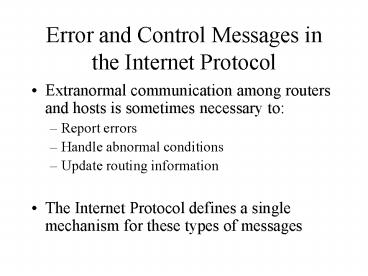Error and Control Messages in the Internet Protocol PowerPoint PPT Presentation
Title: Error and Control Messages in the Internet Protocol
1
Error and Control Messages in the Internet
Protocol
- Extranormal communication among routers and hosts
is sometimes necessary to - Report errors
- Handle abnormal conditions
- Update routing information
- The Internet Protocol defines a single mechanism
for these types of messages
2
The Internet ControlMessage Protocol (ICMP)
- Normally generated by and intended for the IP
software - Two levels of encapsulation
3
ICMP is for Error Reporting
- Errors are reported to a datagrams original
sender - It is the senders responsibility to take
appropriate action - Exception ICMP messages are not generated for
errors that result from datagrams carrying ICMP
messages
4
ICMP Message Format
- All ICMP messages begin with the same three
fields - TYPE (1 octet) - identifies the message
- CODE (1 octet) - information about the subtype
- CHECKSUM (2 octets) - covers the ICMP message
- ICMP error messages always include the header and
first 64 data bits of the datagram causing the
problem
5
The ICMP TYPE Field
- Type Field ICMP Message Type
- ------------- --------------------------
- 0 Echo Reply
- 3 Destination Unreachable
- 4 Source Quench
- 5 Redirect
- 8 Echo Request
- 11 Time Exceeded for Datagram
- 12 Parameter Problem on Datagram
- 13 Timestamp Request
- 14 Timestamp Reply
- 15 Information Request (obsolete)
- 16 Information Reply (obsolete)
- 17 Address Mask Request
- 18 Address Mask Reply
6
Echo Request and Reply Messages
- IDENTIFIER and SEQUENCE NUMBER
- Used by the sender to match replies with requests
7
Destination Unreachable Messages
- Sent when a router cannot deliver or forward a
datagram
8
Destination UnreachableCODE Field
- Code Value Meaning
- -------------- -----------
- 0 Network Unreachable
- 1 Host Unreachable
- 2 Protocol Unreachable
- 3 Port Unreachable
- 4 Fragmentation needed and DF set
- 5 Source Route Failed
- 6 Destination Network unknown
- 7 Destination Host Unknown
- 8 Source Host Isolated
- 9 Comm. Administratively prohibited (network)
- 10 Comm. Administratively prohibited (host)
- 11 Network unreachable for type of service
- 12 Host unreachable for type of service
9
Congestion and DatagramFlow Control
- Most routers have a limited queue in which to
store arriving datagrams - Congestion - a router is overrun with traffic
- High-speed computer sends datagrams faster than a
router can retransmit them - Many computers send datagrams to the same router
at once
10
Source Quench Message
- Congested routers send one for every datagram
they drop
11
Source Quench Messages
- Hosts that receive source quench messages should
stop sending datagrams to that router
(temporarily) - When it hasnt received a source quench message
in a while, the host can start gradually
increasing its traffic again
12
Redirect Messages
- Hosts initialize routing table at startup
- When a router detects a host using a nonoptimal
route it sends the host a ICMP redirect message
13
Redirect Messages
- Code Value Meaning
- -------------- -----------
- 0 Redirect datagrams for the Net (obsolete)
- 1 Redirect datagrams for the Host
- 2 Redirect datagrams for the Type of Service
and Net - 3 Redirect datagrams for the Type of Service
and Host
14
Time Exceeded Messages
- Code 0 - Datagram dropped because TTL reached 0
- Code 1 - Datagram dropped because fragment
reassembly time exceeded
15
ICMP Security Issues
- ICMP can be a source of security vulnerabilities
- Flaws in ICMP implementation can be exploited
- Recall the teardrop vulnerability in IP
- ICMP is well suited for denial-of-service attacks
- Anyone notice the f (flood) option to ping?
- According to the man page
- This can be very hard on a network and should
be used with caution.
16
Ping of Death
- Attacker constructs an ICMP echo request message
containing 65,510 data octets and sends it to a
victim host
17
Ping of Death (cont)
- The total size of the resulting datagram (65538
octets) is larger than the 65,536 octet limit
specified by IP - Several systems did not handle this oversized IP
datagram properly - Hang
- Crash
- Reboot
- Fixed by software patches
18
Smurf
- Attacker sends ICMP echo request messages to a
broadcast address at an intermediate site - Broadcast address a copy of the datagram is
delivered to every host connected to a specified
network - For some broadcast address, a single request
could generate replies from dozens or hundreds of
hosts - The source address in each request packet is
spoofed so that replies are sent to a victim
machine - Result the victims machine/network is flooded
by ICMP echo replies - Many sites have reconfigured their machines so
that their machines do not respond to ICMP echo
requests sent to a broadcast address
19
Smurf (cont)
20
ICMP - Summary
- ICMP provides a mechanism for extranormal
communication among routers and hosts - Echo request/reply
- Destination unreachable
- Source quench
- Redirect
- Time exceeded
- Sometimes incoming ICMP messages are blocked for
security reasons

